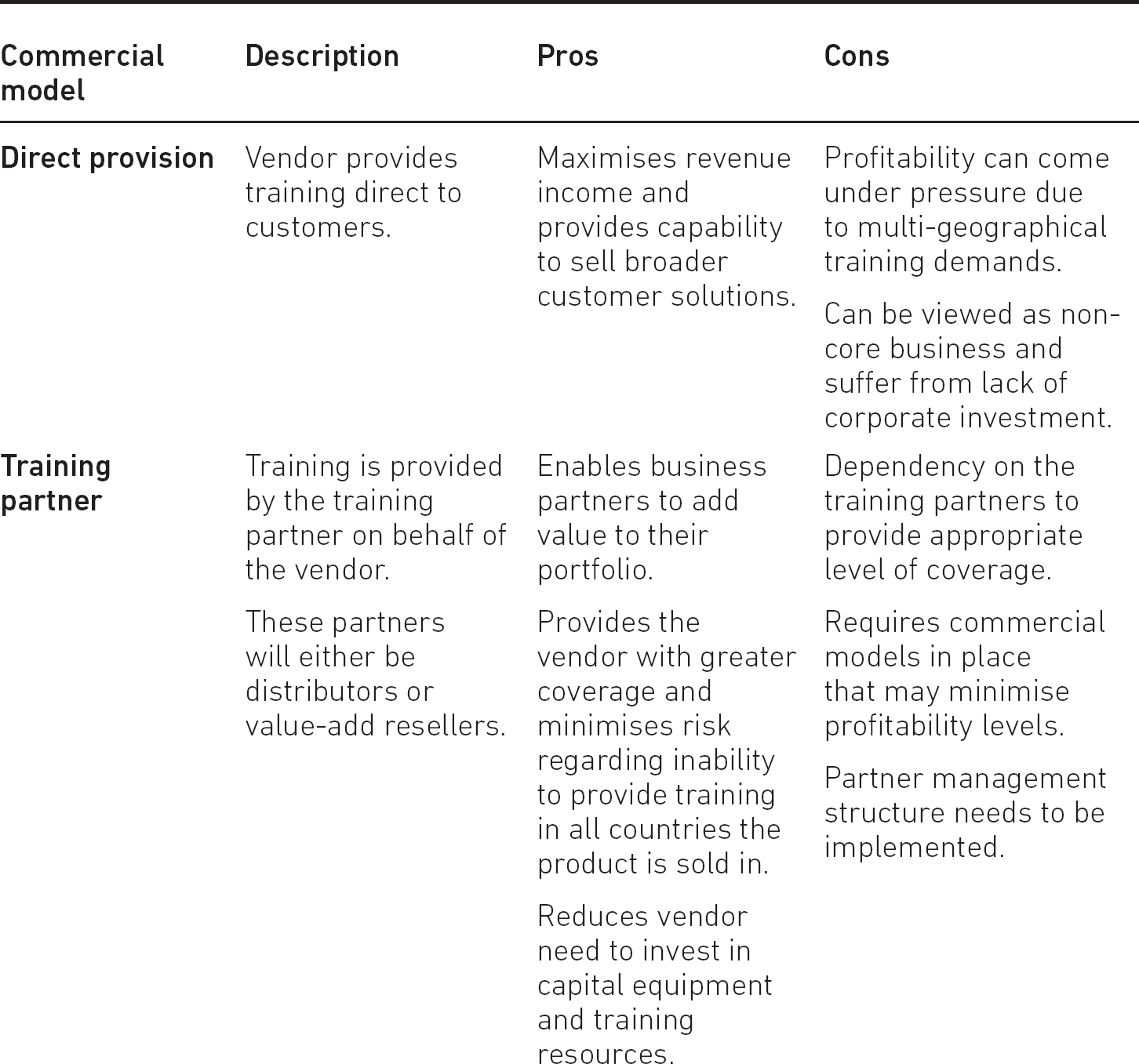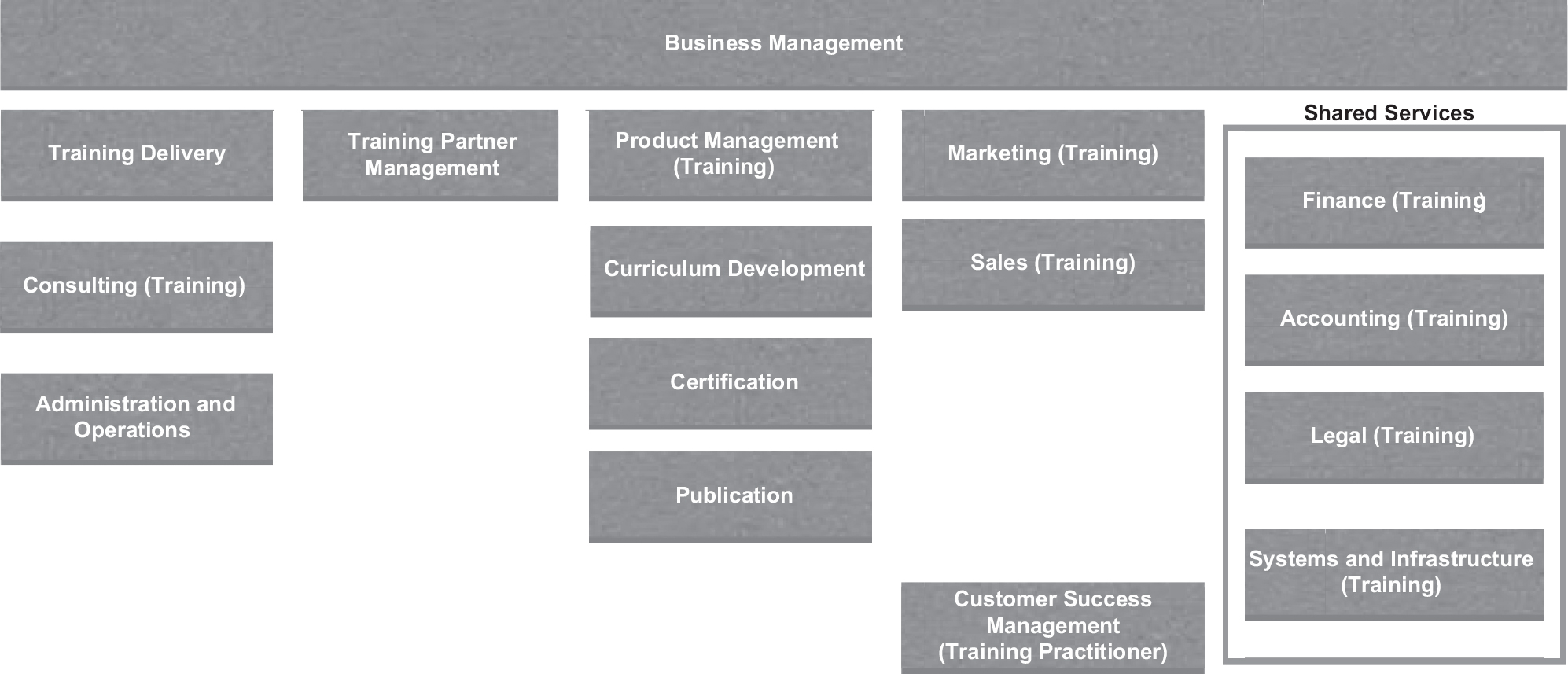This chapter provides an overview of what a technical training organisation provides in terms of its scope, key activities, structure and rationale, and an introduction to the evolving discipline of customer success management and the part it plays in its overall success.
As a career, technical training provides a rich spectrum of opportunities to develop skills, knowledge and business acumen, which are briefly summarised at the end of the chapter in terms of key disciplines.
Technical training covers any aspect of an employee’s job role where they are required to use and apply technical components in the execution of their job.
Technical skills tend to be job specific, whereas so-called soft skills (such as management and negotiation) are independent of role and hence transferable.
The training can cover technology applications, products, sales and service implementation. The scope can be broad and cover the acquisition of knowledge, skills and competencies leading to overall individual or company performance improvement.
Technical training can be purchased directly from a vendor, authorised training partner, contractor or university/college, or it can be provided by an internal training group. Internal training, often known as in-house training, can be delivered by dedicated technical instructors or subject matter experts (SMEs) from within the company.
Vendors who have a service arm to their business will often establish a training group to focus on the provision of both customer and partner-related training, normally for a fee. When the training is diverse or requires a substantial investment in training delivery, they will use a combination of training partners and independent training contractors.
The benefit of investing in technical training is to ensure employees have the confidence and skills necessary to perform their work at a high level, resulting in improved employee morale, efficiency and gaining business benefit from the technology investment.
Customers who invest in technology often require support regarding implementation, obtaining expected returns on investment (ROI) and technical assistance. As a result, most technology manufacturers establish service departments comprising technical support, consulting and training.
On the training front, technology companies may engage third-party training companies or business partners, undertake it themselves or a combination of all three, dependent upon market opportunity and need. Whichever model they run with, it will involve some element of commercial activity. Table 1.1 highlights the pros and cons of this.
Table 1.1 Commercial training models

Vendors can achieve good commercial results and ensure customers are well provided for by assessing the prevailing market conditions. Through balancing customer need and potential versus access to training resources, a good commercial environment can be established and maintained.
TYPICAL TRAINING ORGANISATION STRUCTURE
Training organisation structures differ from one vendor to another, depending upon the size of the target market, the nature of what they want to offer, the investment profile and the functions that can be resourced within a shared services environment.
The organisation chart shown in Figure 1.1 is represented in terms of functional departments. Overall control comes under the remit of business management and is the responsibility of a training executive or senior manager, depending upon the size of the overall team and its financial structure for profit and loss (P&L), cost centre or breakeven.
Shared service functions, such as finance, accounting, legal, and systems and infrastructure, typically come under the respective corporate departments, with remits to allocate staff to support the training group on a daily basis. For the corporation, it represents significant savings in terms of minimising duplication of activities.
Marketing may also be under a shared services remit dependent upon the corporate position regarding alignment of messages, activities and allowable spend the corporation wants to allocate to general marketing activities.
Sales may reside under a professional services structure comprising consulting, technical support and training, dependent upon revenue targets and organisational need. The training sales team may be structured around direct and telesales activities.
Telesales focus their attention on transactional sales activities such as selling places on a public schedule or eLearning offerings below a certain value. The direct sales team undertakes customer account management and sells larger or more complex deals.
The training product management team liaises and works closely with corporate product management to ensure alignment of service-related offerings. Curriculum development with its instructional designers, content and lab developers works closely with product management to interpret their requests and develop training offerings.
Certification and publication teams also work closely with the curriculum team. Publications are responsible for ensuring training offerings – eLearning, instructor-led training (ILT) and virtual instructor-led training (VILT) – are available and distributed in accordance with requests from the administration and operations team following confirmed sales activities. Certification develops examinations on behalf of the curriculum development team and distributes examinations, including pass/fail results, to requesting students.
Training partner management has responsibility for engaging partners who sell and deliver training and for ensuring quality of delivery and sales targets are achieved.
Courses and offerings sold by the sales team are passed to the administration and operations team, who accept bookings and coordinate the distribution of joining instructions and scheduling of resources such as instructors and training rooms. On completion of an instructor-led course or student receipt of an eLearning or subscription offering, accounting are advised to initiate customer invoicing.
Figure 1.1 Typical organisation chart

The training delivery team, working in conjunction with the administration and operations team, assists in the planning of course schedules and the delivery of training. The consulting team supports requests from customers requiring specialised training solutions specific to their needs.
To accommodate requests for training in geographies or markets where the training delivery team does not have a presence, the training partner management team enlists and manages authorised partners to sell and deliver on behalf of the training group.
Quality management, covering planning, assurance, control and improvement, comes under the remit of the training business management team. Each manager assesses how overall quality ensures the training service and offerings provided satisfy the intended function. All employees within the training group are held responsible for ensuring quality of service is maintained throughout their activities.
The organisation structure will vary from one company to another, but the functional elements will exist for all. For companies initiating a training department for the first time, many of the elements will reside with the training delivery team. For those who are servicing large training volumes, the elements may subdivide. One example of this is in the area of curriculum development where additional functional elements become departments in their own right, such as eLearning and lab development.
The processes and organisational needs required to ensure all stages of the customer experience are effective need to be defined and in place before customers are engaged.
Customer success management
Customer success management is growing in popularity, specifically in the technical arena. Primarily, the role is based on understanding the needs of the customer and using this to develop a shared vision, establish joint accountability and prioritise their long-term success above all else.
Its key driver is customer retention and requires the provision of dedicated resources on the training side to help align provider and customer in a homogeneous manner. With continuous pressure from competitors, staying one step ahead is a key factor for continued success. For a technical training manager, customer success management alignment is as vital as that of sales account management.
From a training perspective, it is financially astute to assess which customers are crucial to overall company success and what type of coverage is required. This then allows a decision to be made on how many customer success training practitioners are allocated to support the company-dedicated customer success managers, and how best to ensure the full alignment of corporate and customer need.
TECHNICAL TRAINING MANAGEMENT AS A CAREER
Does being a technical training manager limit your career prospects? The simple answer is: no!
Executives of high performing organisations understand that commitment and vigorous pursuit of a clear and compelling vision stimulating higher performance standards is the catalyst behind a great company.
Achieving this comes from hiring managers who can organise staff and resources to be effective and efficient in the pursuit of pre-determined objectives. In that sense, whether you are running a technical department or a marketing department, the principles of management are the same.
Where technical training comes into its own is the diversity of the roles it encompasses:
- strategic alignment: aligning training provision with product and service needs to ensure overall corporate business objectives are achieved;
- content development: design and development of training offerings that enable customers to capitalise on their investment;
- training delivery: managing instructors and training resources to ensure customers have access to training when and where they need it;
- technology management: providing technical resources in support of system infrastructural needs;
- administration services: supporting registrations, bookings, invoicing, scheduling and coordination of resources;
- partner management: establishing partner networks to support coverage and expansion of geographic markets;
- training product management: the design, build, operation and maintenance of the training offering, including marketing need, position and pricing;
- sales management: selling and achieving desired revenue goals;
- business analysis: assessing market potential, coverage and price points for new and existing training offerings;
- business development: expanding the training organisation’s reach into new and existing markets;
- release management: ensuring course and certification releases are clearly coordinated across both internal and external stakeholders.
In running the business, motivating the team is a key element. However, staying focused on the business itself is crucial. Synchronising training activities with the rest of the company is fundamental to its success and its ability to influence at the highest level. With that in mind, the role of a technical training manager provides a rich spectrum of skills, knowledge and business acumen to launch a move into higher executive management.
Customers who invest in technology require training support in order to maximise their expected return on investment. As a result, most technology manufacturers establish training departments to educate and train customer employees to use and apply the technology in the execution of their job role.
Companies who provide training may engage third-party training organisations and business partners, or undertake it themselves to satisfy the market opportunity and need.
The organisational training structure will differ from one vendor to another, depending upon the size of the market, what they want to offer, investment availability and what business functions they need to provide or can be accessed within a shared services environment.
Business management and control is determined by the company’s functional activity and financial reporting needs, such as P&L, cost centres or breakeven.
With the rapid and growing acceptance that customer success management is a crucial component of maintaining a strong and meaningful relationship, technical training must be a key consideration for inclusion.
As a career, training management provides a rich landscape in which to gain broad-based skills across multiple disciplines and contribute in an effective and productive manner to the overall success of a company.

